
We all love studying the back covers of the magazine–so here, in that vein, are more vintage garments to inspire and educate.
These vintage clothes are part of the private collection of Cindy Vincent, author and business owner of Mysteries by Vincent, murder mystery party games. Many of her party games are historically-based, so participants have a chance to dress-up in vintage clothes and vintage clothing remakes. Her game line-up includes two sewing and fashion-themed mysteries: “Stiffed at the Sewing Store” or “Who Needled the Knock-off?”; and “A Fairly Fatal Fashion Show” or “Who Clipped the Copycat?”. Her vintage clothing collection includes pieces from the Victorian era all the way to the early 1960s, though she has a special interest in the attire of the 1940s.
So here, in her own words, are Cindy’s descriptions of some of the garments in her collection.
“This first dress is one of my faves! I bought it in Alaska-it’s a Parnes Feinstein and was supposedly worn by one of Alaska’s first lady’s. (Though I haven’t been able to prove or disprove this fact yet.) In any case, I find that interesting since it’s a late 1950s or early 1960s dress, which would have been around the time when Alaska became a state (1959). What a fascinating and exciting time to be in that part of the world! I’m guessing the dress is silk, and underlined with silk organza. It’s got some stunning cutwork and corded embroidered flowers-looks like cord was covered with embroidery thread and then sewn on.



This dress is from the 40’s, probably silk taffeta, with a label of Andora. Once again, we see the double darts on either side at the bustline. And, while the top has some gorgeous lace work, the skirt is what fascinated me the most. The design is made from pintucks, with cording on the backside. |



Here’s my 1880s-1890s jacket, most likely part of a wedding suit. This piece is exquisite! The little attached bolero jacket and the cummerbund are all velvet. I’m not sure what the sleeves are, but the big scallops at the bottom are also velvet. Lace peeks out from beneath those scallops. The collar and bodice beneath the bolero are some type of velvet burnout. At the top is a netting with jet bead design. The entire thing fastens together on the side side with hooks and eyes. And there is also an attached corset underneath it all. In the back is a small peplum, and I believe those are carriage pleats on the sleeves. I bought this in a small town in Wyoming, which would have been consistent with the history, considering the West was still quite wild then, in comparison to the East.

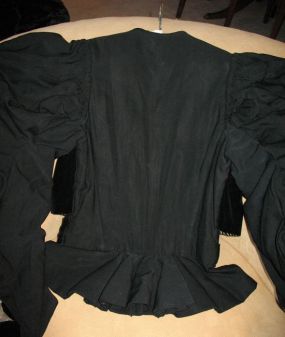

Here’s another fave! This is one of my flapper dresses. I’m guessing it’s silk chiffon. Instead of using fringe for the skirt, the designer created the same effect with these long, double strands of fabric, sewn and turned, and then hand sewn on to create this pattern. So it’s got great swing when doing the Charleston! The neckline and arm openings are all hand turned. I also find it interesting that there are two darts on either side for the bust-line. The rhinestone belt and velvet flower are perfect embellishments. Of course it would have been worn with an underslip.

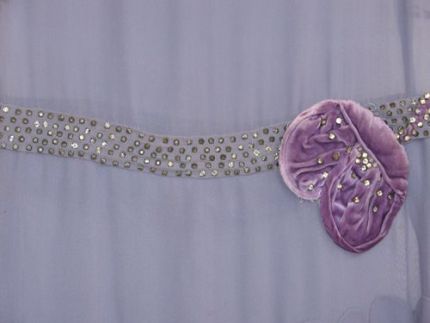

This is that last of the bunch – this blouse is probably Edwardian (think Titanic). It’s black silk with lace inserts and what looks like hand embroidery. This time we have criss-crossed pintucks, and netting on the sleeves and the collar. The back is fastened with hooks and eyes, and the collar is held up with collar stays.”



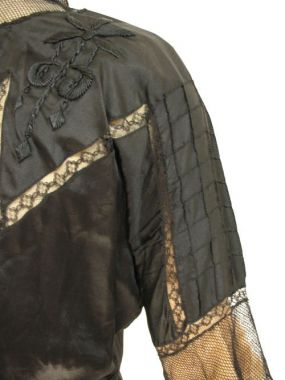
My thanks to Cindy for sharing these with us–her photos, her text, and her enthusiasm!







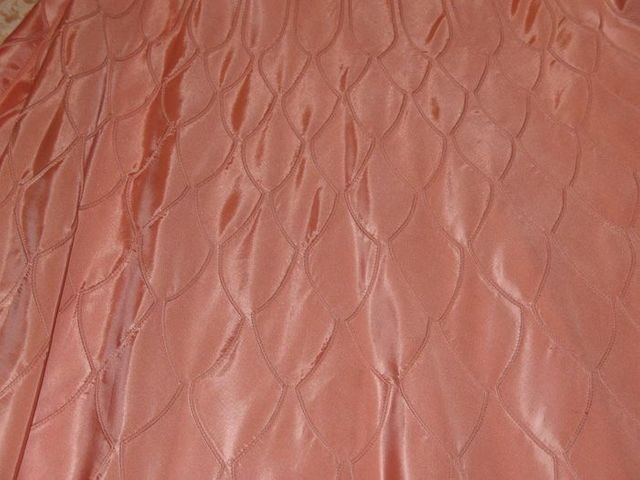













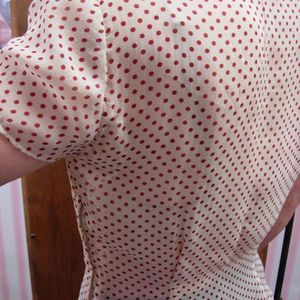


























Oh, how I remember this style. I had several great dresses similar during the late '50 and into the early '60;s era. Only wish I could wear the same style again, but alas, age doesn't improve one's waistline, I fear. It is a gorgeous example of how simple clothing can make an impact on us and even still remain in style years later. I look at today's 'runway' clothing and sometimes I have to shake my head in disbelief. Fortunately there is a publication such as Threads, which I have been a subscriber of since sometime during the late '80's, and wouldn't want to miss an issue. Thanks for being an inspiration and showing the younger women/men who love to sew such unique ideas, some even from the past.
Love those vintage designs! I do some costuming for community theatre as one of my sewing interests and I, too, love those 40's! They often have so many interesting seamlines, probably because they had little fabric during the war and had to piece things together! Out of necessity comes wonderful design! It's so much fun to research the era of a show when making a costume - and on low (or none) community theatre budgets, so nice to use new techniques to get away with murder on stage sometimes! I've even made buttons from bottle caps - close your couture ears, Susan! I have many vintage gloves, shoes etc. decorating shelves in my sewing room, and what a treat to see the details on authentic pieces! Thanks for sharing, Susan, you are right up my alley and I love all your tips and couture techniques! I always look forward to an article in Threads from you!
This is a dress for Jackie O. I love the vintage designs, but unfortunately it's only a dream. I would love to see our young ladies wear this style.
wow! I love the cording on the peach taffeta dress, it's quite unusual. I've been to murder mystery dinner parties and they are great fun --- even more fun dressing up for the part. fabulous article
I had a dress almost exactly like this. It was a stronger rose color my mother made for me. I wore it as the attendant for my new sister-in-law when she and my brother married. I have so wished that I had all of those old Vogue patterns that my mother bought for me. I know enough now that I could make them fit the larger me.
I really like them all - not sure if the sleeves on the black bolero jacket aren't what we'd call 'Leg of Mutton sleeves'. The pleats on the sleeves are similar - but not exactly the same as those used on the garments worn by QC's /Barristers etc in our courts. These garments are made in Silk but I can't remember the correct name for the pleats but for the record i will find out!
Love the vintage pieces! I have created 1880's bodices similar to the black one shown. they have such flattering lines when worn.
I think those might be cartridge pleats in the sleeves.
Love the 20's dress. Might have to copy that for an Art Deco Society event.
I enjoyed viewing and reading about your vintage pieces. I have a wedding suit that was hand-sewn by either my great-grandmother or great-great-grandmother; circa 1880. It is olive green with fabulous details. I have both the skirt and the jacket. My mother wore this suit for her own wedding in 1950. The waist of the long skirt is 18 inches, which tells you how much we have grown in the last 100 years. In addition I have my grandmothers wedding dress/outfit from the 20's. It is a beautiful white/off white chiffon with beading and tassels. Thank you for sharing your garments. I love being reminded there was a time when most people took pride in how they dressed and put loving care into the details of the garments they created.
Oooooooh, Ahhhhhh! How I love the vintage clothing! They used so many wonderful techniques. I was lucky enough to have won the bid at an auction a few yrs ago that brought me a vintage 1890's traveling suit in wool gabardine and silk. It too has built in boning, similar to a corset. Research and my love for history has brought me to a prior period and I am currently making my clothing for Civil War Reenactment. All of my undergarments are made by hand and I am nearly ready to make a day dress. The ball gown that follows it will be my biggest challenge. I've chosen an Italian Scalamadre silk taffeta for that one...it will take a little while to save for that fabric... The couture techniques I've learned from Susan's book have helped me immensely! I really loved the recent article in Threads on making a muslin. I also pulled out number 145 for the article 'Party dresses that stay put.' I do custom sewing and have a client that wants a MTB gown made from raw silk. A few yrs ago I never would have attempted this, but THANKS to Susan's books and articles I've learned the techniques needed to make this gown correctly. I've convinced my client to spend the extra and go 'couture' with this gown. (Most people in my small town would never go beyond what the pattern instructions call for) So THANKS, Susan, for all the help you give when you write your books and articles. For those of us who can't afford to attend your classes, they is so very valuable! Please keep the articles coming.
Deb